Seasonal influences on sleep and executive function in the migratory White-crowned Sparrow (Zonotrichia leucophrys gambelii)
- PMID: 20670404
- PMCID: PMC2923628
- DOI: 10.1186/1471-2202-11-87
Seasonal influences on sleep and executive function in the migratory White-crowned Sparrow (Zonotrichia leucophrys gambelii)
Abstract
Background: We have previously shown that the White-crowned Sparrow (WCS) decreases sleep by 60% during a period of migratory restlessness relative to a non-migratory period when housed in a 12 h light: 12 h dark cycle. Despite this sleep reduction, accuracy of operant performance was not impaired, and in fact rates of responding were elevated during the migratory period, effects opposite to those routinely observed following enforced sleep deprivation. To determine whether the previously observed increases in operant responding were due to improved performance or to the effects of migration on activity level, here we assessed operant performance using a task in which optimal performance depends on the bird's ability to withhold a response for a fixed interval of time (differential-reinforcement-of-low-rate-behavior, or DRL); elevated response rates ultimately impair performance by decreasing access to food reward. To determine the influence of seasonal changes in day length on sleep and behavioral patterns, we recorded sleep and assessed operant performance across 4 distinct seasons (winter, spring, summer and fall) under a changing photoperiod.
Results: Sleep amount changed in response to photoperiod in winter and summer, with longest sleep duration in the winter. Sleep duration in the spring and fall migratory periods were similar to what we previously reported, and were comparable to sleep duration observed in summer. The most striking difference in sleep during the migratory periods compared to non-migratory periods was the change from discrete day-night temporal organization to an almost complete temporal fragmentation of sleep. The birds' ability to perform on the DRL task was significantly impaired during both migratory periods, but optimal performance was sustained during the two non-migratory periods.
Conclusions: Birds showed dramatic changes in sleep duration across seasons, related to day length and migratory status. Migration was associated with changes in sleep amount and diurnal distribution pattern, whereas duration of sleep in the non-migratory periods was largely influenced by the light-dark cycle. Elevated response rates on the DRL task were observed during migration but not during the short sleep duration of summer, suggesting that the migratory periods may be associated with decreased inhibition/increased impulsivity. Although their daily sleep amounts and patterns may vary by season, birds are susceptible to sleep loss throughout the year, as evidenced by decreased responding rates following enforced sleep deprivation.
Figures
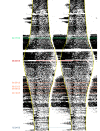
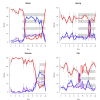
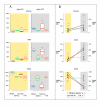

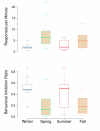



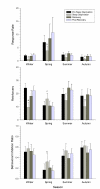
Similar articles
-
Migratory sleeplessness in the white-crowned sparrow (Zonotrichia leucophrys gambelii).PLoS Biol. 2004 Jul;2(7):E212. doi: 10.1371/journal.pbio.0020212. Epub 2004 Jul 13. PLoS Biol. 2004. PMID: 15252455 Free PMC article.
-
Circadian and masking control of migratory restlessness in Gambel's white-crowned sparrow (Zonotrichia leucophrys gambelii).J Biol Rhythms. 2008 Feb;23(1):59-68. doi: 10.1177/0748730407311456. J Biol Rhythms. 2008. PMID: 18258758
-
Plasma corticosterone increases during migratory restlessness in the captive white-crowned sparrow Zonotrichia leucophrys gambelli.Horm Behav. 2004 Dec;46(5):574-81. doi: 10.1016/j.yhbeh.2004.06.006. Horm Behav. 2004. PMID: 15555499
-
Circannual rhythms in birds.Curr Opin Neurobiol. 2003 Dec;13(6):770-8. doi: 10.1016/j.conb.2003.10.010. Curr Opin Neurobiol. 2003. PMID: 14662381 Review.
-
Control and adaptability of seasonal changes in behavior and physiology of latitudinal avian migrants: Insights from laboratory studies in Palearctic-Indian migratory buntings.J Exp Zool A Ecol Integr Physiol. 2022 Dec;337(9-10):902-918. doi: 10.1002/jez.2631. Epub 2022 Jun 8. J Exp Zool A Ecol Integr Physiol. 2022. PMID: 35677956 Review.
Cited by
-
Cortical region-specific sleep homeostasis in mice: effects of time of day and waking experience.Sleep. 2018 Jul 1;41(7):zsy079. doi: 10.1093/sleep/zsy079. Sleep. 2018. PMID: 29697841 Free PMC article.
-
Unraveling the Evolutionary Determinants of Sleep.Curr Biol. 2016 Oct 24;26(20):R1073-R1087. doi: 10.1016/j.cub.2016.08.068. Curr Biol. 2016. PMID: 27780049 Free PMC article. Review.
-
Use of Actigraphy for a Rat Behavioural Sleep Study.Clocks Sleep. 2021 Aug 2;3(3):409-414. doi: 10.3390/clockssleep3030028. Clocks Sleep. 2021. PMID: 34449568 Free PMC article.
-
Neuroscience: A Distributed Neural Network Controls REM Sleep.Curr Biol. 2016 Jan 11;26(1):R34-5. doi: 10.1016/j.cub.2015.11.011. Curr Biol. 2016. PMID: 26766231 Free PMC article.
-
Mars 520-d mission simulation reveals protracted crew hypokinesis and alterations of sleep duration and timing.Proc Natl Acad Sci U S A. 2013 Feb 12;110(7):2635-40. doi: 10.1073/pnas.1212646110. Epub 2013 Jan 7. Proc Natl Acad Sci U S A. 2013. PMID: 23297197 Free PMC article.
References
-
- DeWolfe BB. Zonotrichia leucophrys gambelii (Nuttall), Gambel's White-crowned Sparrow. Life histories of North American cardinals, grosbeaks, buntings, towhees, finches, sparrows and, allies. 1968;237:1324–1338.
-
- Fuchs T, Haney A, Jechura TJ, Moore FR, Bingman VP. Daytime naps in night-migrating birds: behavioural adaptation to seasonal sleep deprivation in the Swainson's thrush, Catharus ustulatus. Animal Behaviour. 2006;72:951–958. doi: 10.1016/j.anbehav.2006.03.008. - DOI
Publication types
MeSH terms
LinkOut - more resources
Full Text Sources

